Brother PT-2350 User Manual
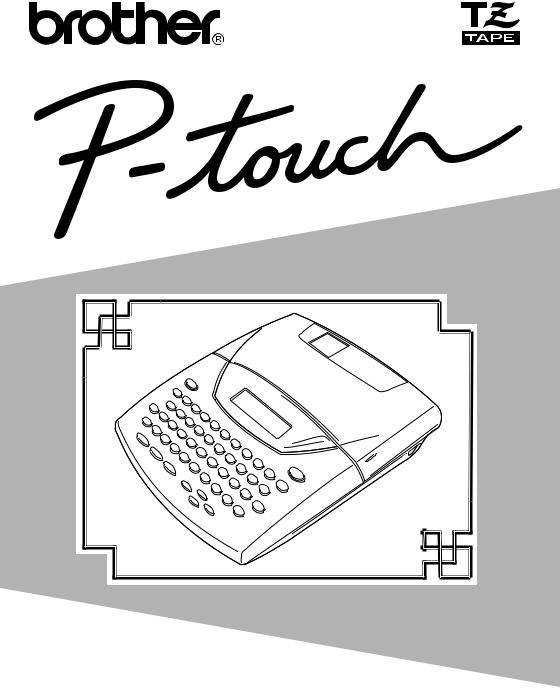
2350
USER’S GUIDE
•Read this User’s Guide before you start using your P-touch.
•Keep this User’s Guide in a handy place for future reference.
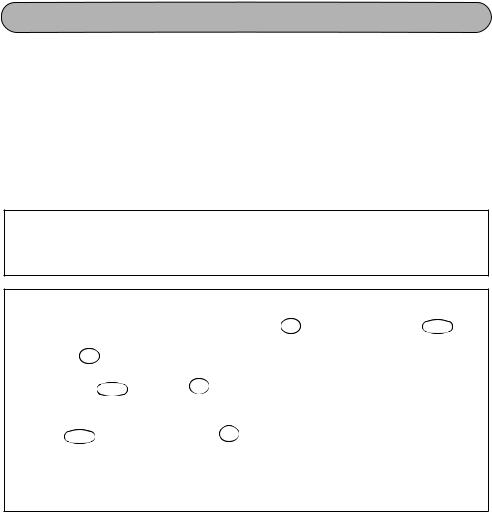
INTRODUCTION
Thank you for purchasing the P-touch 2350!
Your new P-touch will allow you to create labels and stamps for any need. Its versatility enables you to design custom labels by choosing from a variety of frame designs and from many characters sizes and styles. In addition, the five tape widths (1/4” (6 mm), 3/8” (9 mm), 1/2” (12 mm), 3/4” (18 mm), and 1” (24 mm)) and variety of tape colors allow you to print personalized labels, useful for color-coded filing. With the Stamp function, you can quickly and easily make stamps for reusable pre-inked stamp holders.
You no longer have to worry about urgent tasks that require professional printing. In the office, the factory, the lab, and the home, the quality and performance of the P-touch 2350 make it an extremely practical machine.)
Canadian Department of Communications Compliance Statement
This digital apparatus does not exceed the Class B limits for radio noise emissions from digital apparatus as set out in the interference-causing equipment standard entitled “Digital Apparatus”, ICES-003 of the Department of Communications.
Switching the language of the messages between English and French
|
|
|
|
|
|
|
|
|
|
|
|
|
Clear |
|
|
|
1. |
Erase all of the text in the display either with |
Del |
or by holding down |
Code |
and |
|||||||||||
|
|
|
|
|
|
|
|
|
|
|
|
|
|
|
|
|
|
|
|
|
|
|
|
|
|
|
|
|
|
|
|
|
|
|
|
|
Clear |
|
|
|
|
|
|
|
|
|
|
|
||
|
pressing |
Del |
. |
|
|
|
|
|
|
|
|
|
|
|||
|
|
|
|
|
|
|
|
|
|
|
|
|
||||
|
|
|
|
|
|
|
|
|
||||||||
2. |
Hold down |
|
|
and press |
F |
|
to display the current language setting (“ENGLISH” |
|||||||||
|
Code |
|||||||||||||||
|
|
|
|
|
|
|
|
|
|
|
|
|
|
|
||
|
|
|
|
|
|
|
|
|
|
|
|
|
|
|
|
|
|
or “FRANÇAIS”). |
|
|
|
|
|
|
|
||||||||
|
|
|
|
|
||||||||||||
3. |
Keep |
|
|
|
|
held down and press |
|
F |
again until the desired setting appears in the |
|||||||
Code |
|
|||||||||||||||
|
|
|
|
|
|
|
|
|
|
|
|
|
|
|
|
|
|
|
|
|
|
|
|
|
|
|
|
|
|
|
|
|
|
display, then release the keys.
The default setting is English.
Turning off the machine does not change the language setting.
The language cannot be changed if some text remains in the display.
Use only the adaptor designed exclusively for this machine. See GENERAL PRECAUTIONS on page 4.
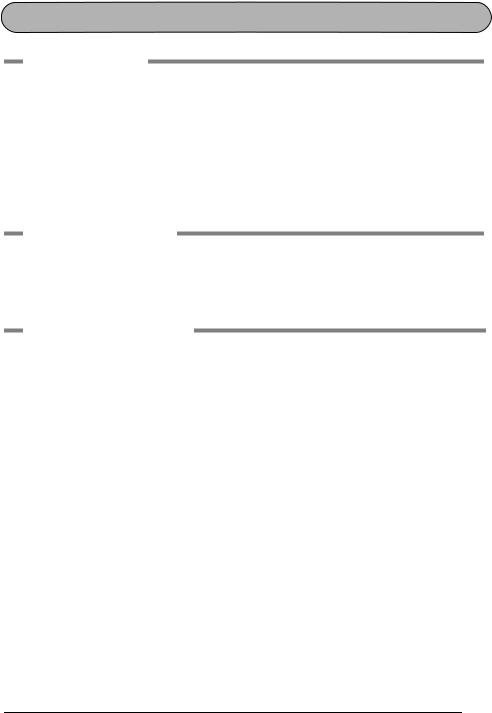
CONTENTS |
|
Getting Started |
|
GENERAL DESCRIPTION .................................................................................... |
2 |
GENERAL PRECAUTIONS................................................................................... |
4 |
BATTERIES .......................................................................................................... |
5 |
OPTIONAL AC ADAPTOR .................................................................................. |
6 |
TAPE CASSETTE .................................................................................................. |
7 |
ATTACHING LABELS .......................................................................................... |
8 |
PRINT HEAD & ROLLERS ................................................................................. |
12 |
Learning the Ropes |
|
DOOR LABEL EXAMPLE ................................................................................... |
14 |
ADDRESS LABEL EXAMPLE............................................................................... |
18 |
STORAGE SHELF LABEL EXAMPLE ................................................................... |
24 |
For Your Information |
|
POWER KEY...................................................................................................... |
32 |
CURSOR KEYS .................................................................................................. |
33 |
CODE, ALT & SHIFT KEYS ................................................................................ |
35 |
SPACE KEY ........................................................................................................ |
38 |
RETURN KEY .................................................................................................... |
39 |
NEW BLOCK FUNCTION ................................................................................. |
40 |
TAB FUNCTION ............................................................................................... |
41 |
DELETE KEY ...................................................................................................... |
43 |
LINE OUT FUNCTION...................................................................................... |
44 |
CLEAR FUNCTION ........................................................................................... |
45 |
ACCENT FUNCTION ........................................................................................ |
48 |
SYMBOL FUNCTION........................................................................................ |
50 |
AUTO FORMAT FUNCTION ............................................................................ |
52 |
STAMP FUNCTION .......................................................................................... |
62 |
LOCAL FORMAT FUNCTION ........................................................................... |
65 |
FONT FUNCTION ............................................................................................ |
66 |
SIZE & WIDTH FUNCTIONS ............................................................................ |
68 |
STYLE FUNCTION ............................................................................................ |
72 |
I

UNDERLINE FUNCTION .................................................................................. |
75 |
FRAME FUNCTION .......................................................................................... |
76 |
TAPE MARGIN FUNCTION .............................................................................. |
78 |
HORIZONTAL ALIGNMENT FUNCTION ......................................................... |
79 |
MIRROR PRINTING FUNCTION ...................................................................... |
80 |
LENGTH FUNCTION ........................................................................................ |
81 |
BARCODE FUNCTION ..................................................................................... |
83 |
AUTO CUT FUNCTION ................................................................................... |
87 |
PRINT KEY AND FEED & CUT FUNCTION....................................................... |
88 |
NUMBERING FUNCTION ................................................................................ |
89 |
REPEAT PRINTING FUNCTION ........................................................................ |
92 |
MEMORY FUNCTIONS .................................................................................... |
94 |
TROUBLESHOOTING ...................................................................................... |
98 |
ERROR MESSAGE LIST ...................................................................................... |
99 |
SPECIFICATIONS ............................................................................................ |
104 |
ACCESSORIES ................................................................................................. |
105 |
II
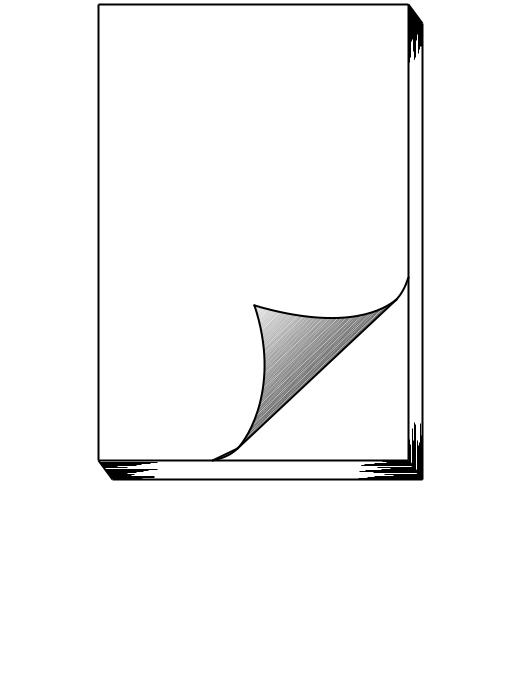
Getting Started
1
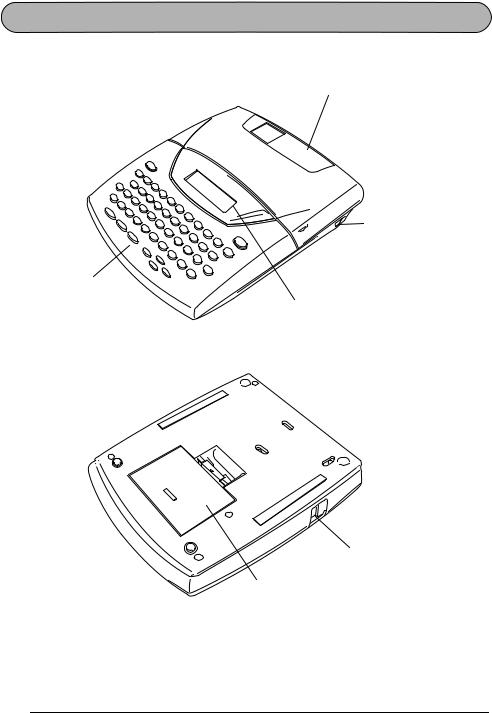
GENERAL DESCRIPTION
TOP VIEW
Tape compartment cover
AC adaptor connector
Keyboard
LCD display
BOTTOM VIEW
Tape exit slot
Battery compartment cover
2
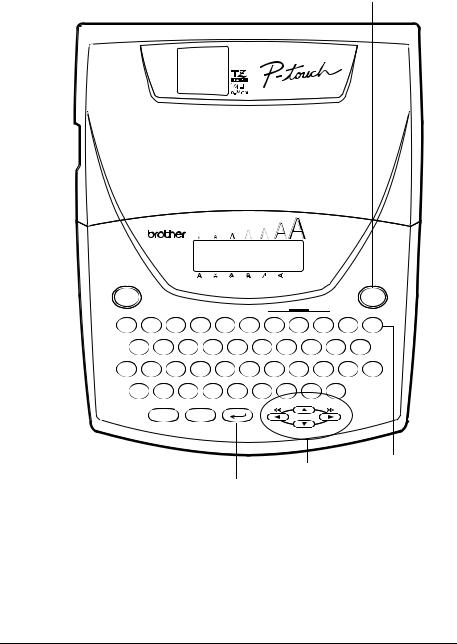
KEYBOARD & LCD DISPLAY
Power key
Length
Undl/Frm
A.Format
|
|
|
|
|
|
|
|
|
|
Width |
|
|
|
|
|
Mirror |
|
|
|
|
|
|
|
|
|
|
|
|
|
|
|
|
|
|
|
|
|
|
|
|
|
|
|
|
|
On |
|
|
|
|
|
|
|
|
|
|
|
|
|
|
|
Off |
|
|
|
|
|
|
|
|
|
|
|
Memory |
|
|
|
||
|
|
|
|
|
|
|
|
|
|
|
|
|
|
||
Font |
Size |
Width |
Style |
|
Underline Frame |
Store |
Recall |
M.Del |
Line out |
Clear |
|||||
! |
@ |
|
# |
$ |
|
% |
|
¢ |
|
& |
* |
( |
) |
|
Del |
1 ¡ |
2 |
|
3 |
4 |
|
5 |
|
6 |
|
7 |
8 |
9 |
0 |
|
|
Tab |
|
Tab Length |
Tape |
Align |
Length |
A.Format Stamp Barcode Repeat |
Number |
||||||||
Q |
|
W |
|
E |
R |
|
T |
|
Y |
U ü |
I í |
|
O ó |
P á |
|
Symbol |
Accent |
Local |
|
|
|
|
|
|
|
|
|
|
|
|
|
Alt |
A |
|
S |
D |
|
F |
|
G |
|
H |
J ¿ |
K é |
L |
|
: |
|
|
|
|
ú |
; " |
||||||||||
Caps |
A.Cut |
|
|
|
|
|
|
|
|
|
|
|
|
|
|
Shift |
Z |
|
X |
C |
Ç |
V |
ç |
B |
N |
M |
|
/ |
|
|
|
|
|
|
|
|
|
|
|
Ñ |
ñ |
|
, - |
|
|
||
|
|
|
|
Feed&Cut |
|
New Block |
|
|
Home |
|
|
|
|
||
|
|
|
|
|
|
|
|
|
|
|
|
||||
|
|
Code |
Space |
|
|
|
|
|
|
|
|
|
|
||
End
Delete key
Cursor keys
Return key
3

GENERAL PRECAUTIONS
•Use only Brother TZ tapes with this machine. Do not use tapes that do not have the  mark.
mark.
•Do not pull on the tape being fed from the P-touch. This may damage the tape cassette.
•Do not use the machine in dusty places, and keep it out of both direct sunlight and rain.
•Do not expose the machine to high temperatures or high humidity. Never leave it on the dashboard or in the back of your car.
•Do not leave any rubber or vinyl on the machine for an extended period of time. Doing so may cause staining.
•Do not clean the machine with alcohol or other organic solvents. Use a soft, dry cloth only.
•Do not put any foreign objects into or anything on the machine.
•To avoid injuries, do not touch the cutter’s edge.
•Use only the AC adaptor (model AD-60) designed exclusively for this machine. Use of any other adaptor will void the warranty.
•Do not try to disassemble the AC adaptor.
•When the machine is not being used for a long period of time and it is not necessary to keep the text files stored in the memory, disconnect the AC adaptor, and remove the batteries to prevent them from leaking and damaging the machine.
•If the AC adaptor is unplugged and no batteries are installed, all text files in the memory may be deleted.
•Use eight AA alkaline batteries in this machine.
4
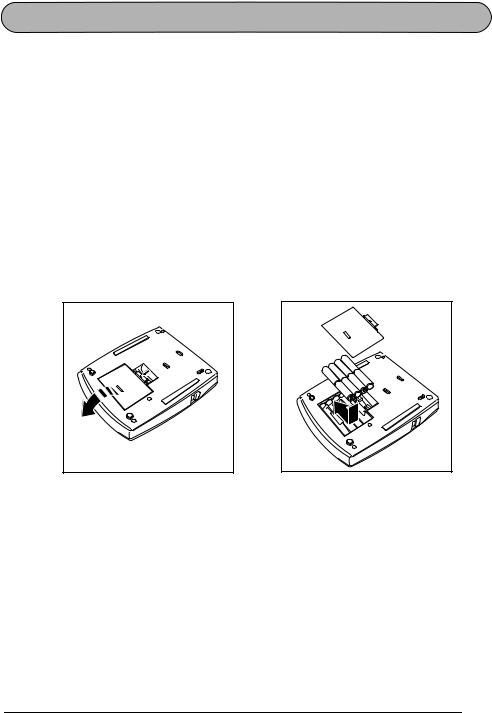
BATTERIES
This lightweight and portable machine can be used anywhere by installing eight (8) AA alkaline batteries. When you change the batteries, always replace all eight at the same time.
To change the batteries:
1Remove the battery compartment cover on the back of the machine.
2If batteries are already installed, remove them.
3Insert eight new AA alkaline batteries, making sure that they face the correct direction.
4Attach the battery compartment cover.
If alkaline batteries are not used, large fonts cannot be printed.
Be sure to insert the new batteries within five minutes of removing the old ones, otherwise the text shown in the display and any text files stored in the memory will be lost (unless the machine is plugged into an AC outlet with the AC adaptor).
Remove the batteries and disconnect the AC adaptor if you do not intend to use this machine for an extended period of time. When the power is disconnected, all text shown in the display and stored in the memory will be lost.
5
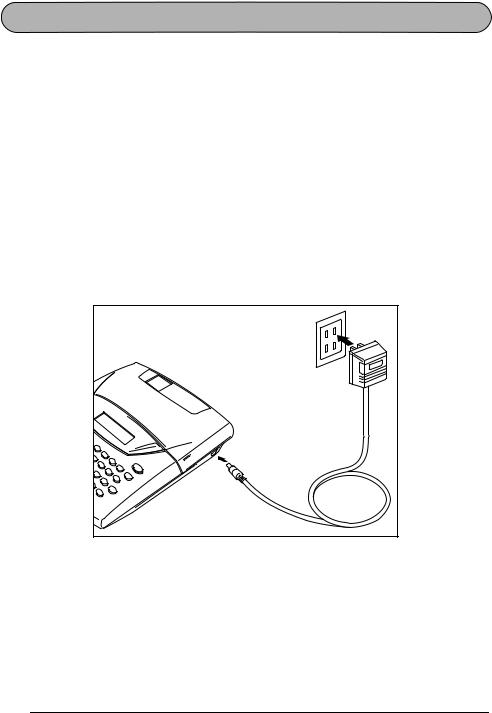
OPTIONAL AC ADAPTOR
The AC adaptor (model AD-60) allows you to use this machine wherever there is an electrical outlet.
To connect the optional AC adaptor:
1Insert the plug on the adaptor cord into the connector marked DC IN 9.5V on the right side of the machine.
2Insert the plug on the adaptor into the nearest standard electrical outlet.
Remove the batteries and disconnect the AC adaptor if you do not intend to use this machine for an extended period of time. When the power is disconnected, all text shown in the display and stored in the memory will be lost.
If the AC adaptor is unplugged and no batteries are installed, all text files in the memory may be deleted.
Only use the AC adaptor designed exclusively for this machine.
It is recommended that you use the AC adaptor when printing large fonts or barcodes on 3/4” (18-mm)- or 1” (24-mm)-wide tape since these operations can quickly drain the batteries.
6
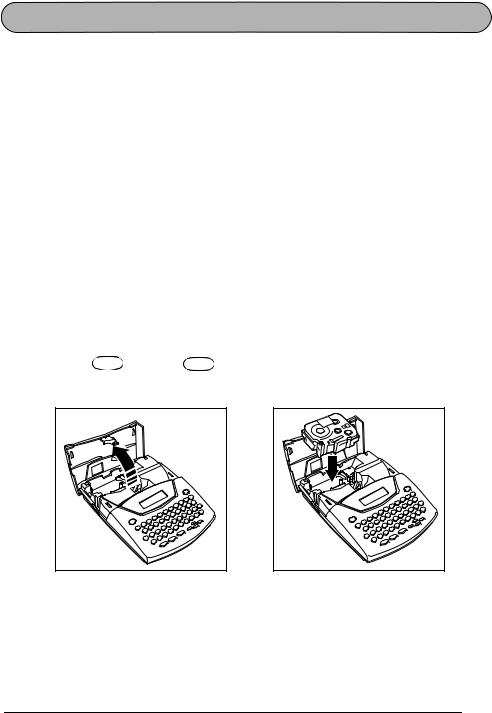
TAPE CASSETTE
A single TZ tape cassette is supplied with this unit. However, since TZ tape cassettes are available for this machine in a wide variety of colors and sizes, it is possible to make distinctive color-coded and stylized labels.
In addition, this machine has been designed to allow you to change the tape cassettes quickly and easily.
To change the tape cassette:
1Lift open the tape compartment cover. The installed cassette is also released.
2If a tape cassette is already installed, remove it by pulling it straight up.
3If the ink ribbon in the other tape cassette is loose, use your finger to wind the toothed wheel in the direction of the arrow on the cassette until there is no slack in the ribbon. Also, make sure that the end of the tape feeds under the tape guides.
If you are using a new tape cassette provided with a stopper, be sure to remove the stopper.
4Insert the tape cassette firmly into the tape compartment, making sure that the entire back of the cassette touches the bottom of the compartment.
|
When inserting the tape cassette, make sure that the inner ribbon does not catch on |
|
the corner of the metal guide. |
5 |
Close the compartment cover, then turn on the machine if it is off. |
|
Feed&Cut |
6 |
Hold down Code and press Space once to remove any slack in the tape and cut off the |
excess.
7
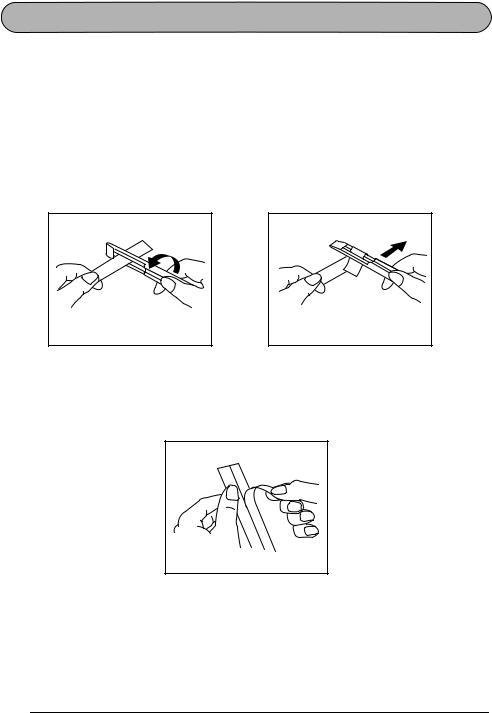
ATTACHING LABELS
LAMINATED TAPE
The enclosed stick enables you to easily remove the backing from labels printed on laminated tapes.
1Hold the tape in your left hand, with the printed surface facing up, and hold the stick in your right hand.
2Pass the tape halfway through the long narrow hole in the stick.
3Turn the stick three-quarters of a turn towards you and pull the stick away from you as shown below.
4Peel off the label backing.
GH
ABCDEF
NON-LAMINATED TAPE
Labels printed on non-laminated tapes can be folded in half so that the inside edges of the two backing pieces come off the label, enabling the backing to easily be peeled off.
8
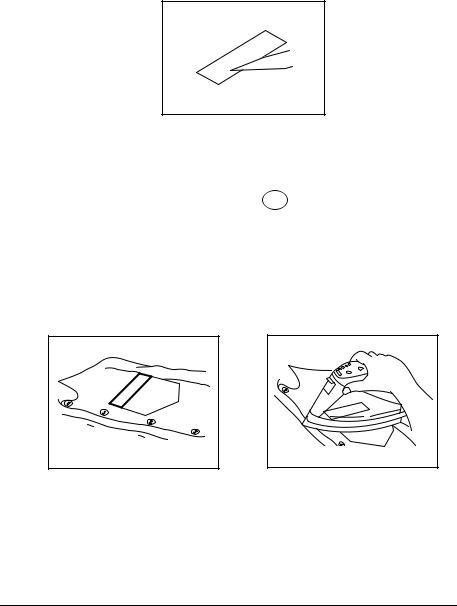
INSTANT-LETTERING TAPE (RUB-ON TRANSFERS)
Instant-lettering tape is used to transfer your text onto paper. After printing the text onto instant-lettering tape and cutting off the label, position the label with its non-printed side facing up on a sheet of paper. By simply rubbing the instant lettering tape’s non-printed side with the enclosed stick, you can transfer the text directly onto the paper.
Hold the tape very firmly and do not move it while rubbing the tape.
ABC
IRON-ON TRANSFER TAPE
Iron-on transfer tape is used to transfer your text onto garments using an iron.
1Insert an iron-on transfer tape cassette, press the tape cutter lever to cut off the label.
Mirror
Print to print the text, then push down on
2Iron the garment to flatten it before transferring the text.
3Place the label on the garment at the location where you wish the text to be transferred.
4Set the iron to cotton (302 to 356 ˚F (150 to 180 ˚C)), then press down on the label with the iron for about 15 seconds.
5Allow the iron-on transfer to cool (for about 60 seconds), and then carefully remove the backing paper.
P |
- |
TOUCH |
|
|
9

White garments made from 100% cotton with a plain (smooth) surface are best for ironon transfers.
You can also make transfers to garments made from 100% linen or cotton/polyester blends as long as they have a plain (smooth) surface.
The label will not adhere properly to any cloth with a rough surface, such as pile or denim, or with a waterproof surface. Heat-sensitive materials, such as nylon, acetate or other similar fibres, are also unsuitable as they may be damaged when pressing with an iron at a high temperature.
Do not move the iron while pressing, otherwise the label may move out of the desired position. Press the iron straight down onto the cloth.
After the backing tape has been removed, the transferred label may appear glossy. In addition, some white spots may have appeared on the label if it was touched while the backing tape was peeled off. These can be removed by ironing over the label with a piece of cloth placed between the label and the iron.
Since the transferred label cannot be removed once it is applied, make all transfers with care.
Washing:
Garments with transfer labels can be washed over 20 times if the label has been transferred correctly. Normal biological and non-biological household detergents may be used.
The label may become discolored if the garment is placed in bleach for an extended length of time.
Be careful that hard objects such as buckles or buttons do not come into contact with the label during the wash.
Do not dry clean garments which have had transfer labels applied.
Drying:
Garments with transfer labels may be dried either inside or outside out.
Do not tumble dry. The transfers will come off and may stick to other items of clothing.
10
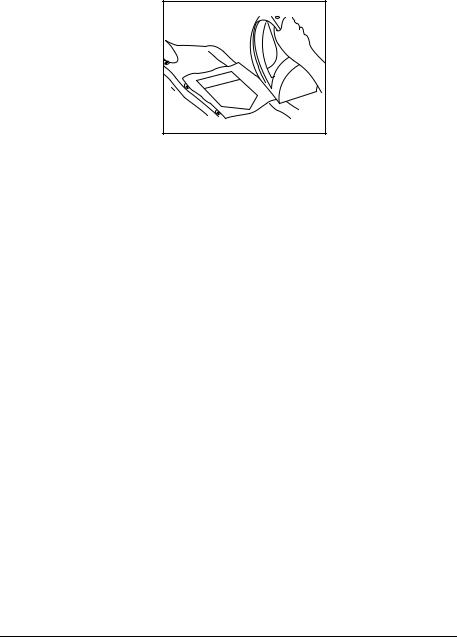
Ironing:
Iron garments with transfers using normal temperature settings.
Be sure to place a piece of cloth between the iron and the label when you iron over it to prevent the label from sticking to the iron.
P-TOUCH
The labels are non-toxic, however, please maintain the usual precautions, such as not placing them in your mouth, etc.
Do not store the tape cassette in areas exposed to direct sunlight, high humidity or dust.
FABRIC TAPE
Fabric tape is used to attach a piece of fabric printed with your text onto garments using an iron. After printing the text onto fabric tape and cutting off the label using scissors, place the label on an ironed garment at the location where you wish to attach it in such a way that the printed text can be read correctly. Cover the label with another piece of cloth and use an iron set to a medium-high temperature (320 to 356 ˚F (160 to 180 ˚C)) to press down firmly for 10 to 15 seconds. For more details, refer to the instructions included with the fabric tape cassette.
The label will have a white background on colored cloth.
STAMP TAPE
Refer to pages 62 through 64 for a detailed explanation on using the stamp tape to make stamps.
11
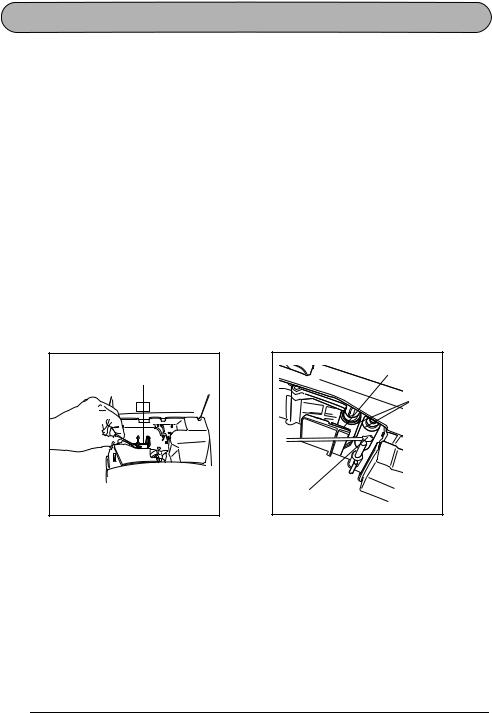
PRINT HEAD & ROLLERS
Occasionally, specks of dust or dirt become attached to the machine’s print head and rollers. This is particularly likely when you are using the unit outdoors or in a very dusty environment. If a section of the print head is covered with dust, a blank horizontal streak may appear through the label text. Therefore, as with a tape recorder, the machine’s head may need to be cleaned from time to time.
To clean the print head and rollers:
1Turn off the machine.
2Open the tape compartment cover, then remove the tape cassette if one is installed. The print head and rollers are located in the tape compartment.
3Print head: Use a dry cotton swab to gently wipe the print head with an up-and-down motion.
Rollers: Use a dry cotton swab to wipe each roller with an up-and-down motion while rotating them with your finger.
4Install a tape cassette, close the tape compartment cover, and then try printing again.
5If dust still remains, repeat steps 3 and 4 using a cotton swab dipped in isopropyl (rubbing) alcohol.
If none of the above works, contact your service representative.
Print head
Print head
Rollers
Cotton swab
12
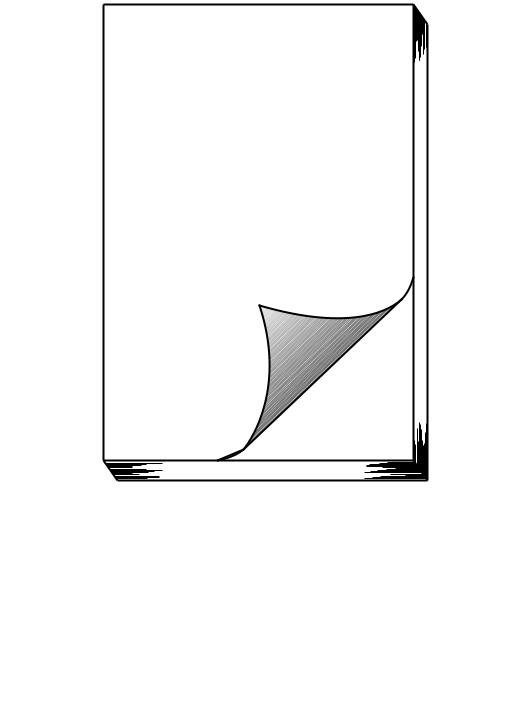
Learning
the Ropes
13

DOOR LABEL EXAMPLE
After you have inserted the batteries and the enclosed tape cassette as explained in the Getting Started chapter, let’s practice using some of the basic functions of your P-touch. We must first begin by turning on the power to the machine.
To turn on the machine:
1 Press |
Off |
in the top right-hand corner |
|
|
|
|
On |
|
|
|
|
of the keyboard. |
Alt |
|
Length |
||
|
|
|
|
|
|
|
|
|
|
1: _ |
Undl/Frm |
|
|
|
Caps |
A.Format |
|
|
|
|
|
|
Width |
The underline in the LCD display is called the “cursor”. It is like a pointer which shows your current position and lets you select characters in your text.
The text you create may sometimes be longer than the 11 characters that the LCD display can show at one time. Therefore, the cursor can be moved to show other parts of the text. Pressing the left cursor key (  ) moves the cursor to the left so that the left side of the text can be
) moves the cursor to the left so that the left side of the text can be
seen and pressing the right cursor key ( |
) moves the cursor to the right so that the right |
side of the text can be seen.
Some format settings are shown by the triangular and square indicators around the edge of the display. The default settings (the selected settings when the power is turned on for the very first time) have been pre-programmed into the machine and represent the most common settings for labels. However, you can design your own label to have any format that you wish. Detailed explanations of the formats can be found on pages 68 through 82.
Now, let’s enter the text for our first example, the simple door label shown below.
The label in this example was made using the enclosed 1/2” (12-mm)-wide tape.
14
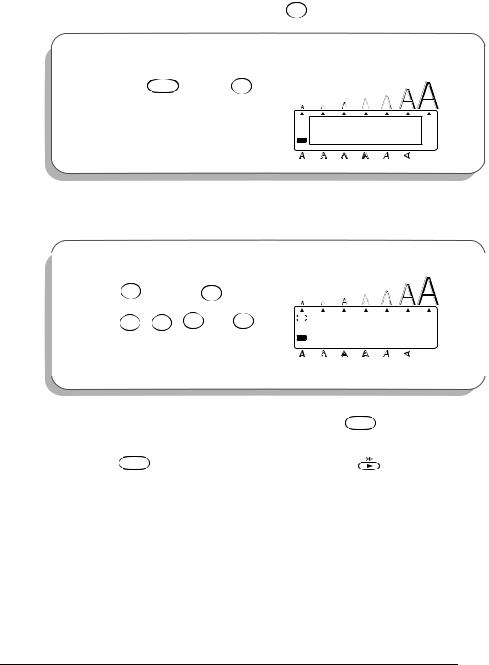
ENTERING THE TEXT
Since all of the text will be in capital letters, we will use the Caps mode, which allows us to
|
Caps |
|
|
type capital letters continuously without holding down |
Shift . |
|
|
To enter Caps mode: |
|
|
|
Caps |
|
|
|
2 Hold down Code and press Shift once. |
|
|
|
The Caps indicator on the left side of the |
|
|
|
display lights up. |
Alt |
|
Length |
|
|
1: _ |
Undl/Frm |
|
Caps |
A.Format |
|
|
|
|
Width |
Then, let’s type in the text in the same way that you would type on a typewriter or a computer keyboard.
|
To type in “MEETING”: |
|
|
|
|
|
|
|
||
|
|
|
|
Tape |
|
|
|
|
|
|
|
3 Press |
M ñ |
once and |
E |
twice, then |
|
|
|
||
|
|
Length |
Barcode |
|
|
|
|
|
|
|
|
press |
T , |
I í , N Ñ |
and |
G once |
Alt |
|
A B C D E F G H I J K L |
Length |
|
|
|
|
|
|
|
|
|
1: M E E T I N G _ |
Undl/Frm |
|
|
each. |
|
|
|
|
Caps |
|
A.Format |
||
|
|
|
|
|
|
|
|
|
|
|
|
All letters are automatically entered as |
|
|
Width |
||||||
|
capital letters. |
|
|
|
|
|
|
|
||
|
|
|
|
|
|
|
|
Feed&Cut |
|
|
Also like on a typewriter or computer keyboard, the Space key ( Space |
) allows you to add |
|||||||||
blank spaces to the text. |
|
|
|
|
|
|
|
|
||
The Space key ( |
Feed&Cut |
) is different from the right cursor key ( |
), which moves the |
|||||||
Space |
||||||||||
cursor through the entered text without adding blank spaces.
15
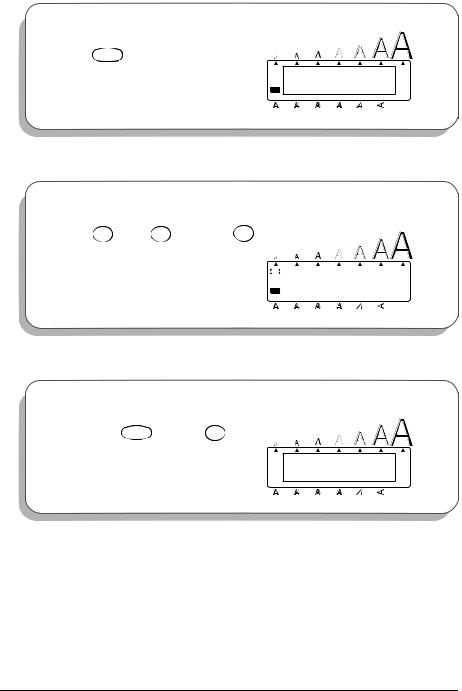
To add a space:
Feed&Cut
4 Press Space .
Alt |
A B C D E F G H I J K L |
Length |
|
1: M E E T I N G _ |
Undl/Frm |
Caps |
A.Format |
|
|
|
Width |
Type the second word, “ROOM”, to finish the text.
To type in “ROOM”:
Align |
Repeat |
|
|
|
|
|
5 Press R |
once, O ó twice, then M ñ |
|
|
|
|
|
once. |
|
|
|
|
|
|
Since the text is longer than the LCD |
|
|
|
|
|
|
Alt |
|
A B C D E F G H I J K L |
|
Length |
||
|
|
|
|
|
||
display, “ME” moves off the display to |
|
|
|
Undl/Frm |
||
|
|
1: E T I N G R O O M _ |
||||
the left. |
|
Caps |
|
A.Format |
||
|
|
|
|
|
|
|
|
|
|
|
|
|
|
|
|
|
|
|
Width |
|
Now that we are finished entering capital letters, we can exit Caps mode.
To exit Caps mode:
Caps
6 Hold down Code and press Shift once.
The Caps indicator goes off.
Alt |
A B C D E F G H I J K L |
Length |
|
1: E T I N G R O O M _ |
Undl/Frm |
Caps |
A.Format |
|
|
|
Width |
Once you have entered the text, you can easily edit it by correcting mistakes or simply adjusting it or its format. For more detailed explanations of text editing methods, see pages 43 and 44.
16
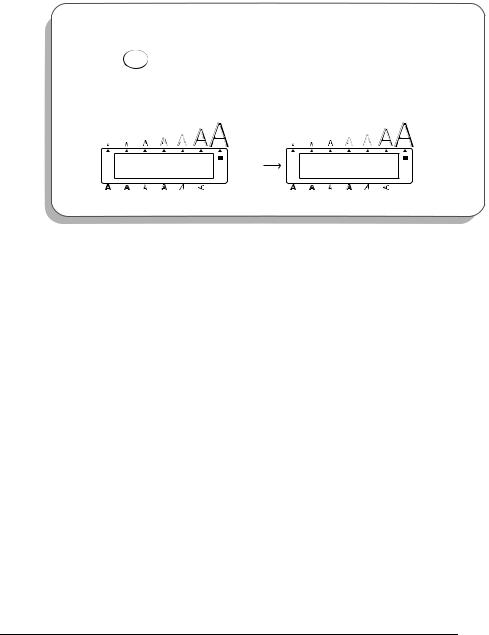
PRINTING THE TEXT
Several format settings are available, however, in this example we will use the default settings pre-programmed into the machine and print out our label, which is then automatically cut off after printing is finished.
To print the door label:
|
Mirror |
|
7 Press |
once. The message “WORKING” appears just before printing, and |
then “COPIES 1/ 1” is displayed while the label is being printed.
If the A.Cut function is set to ON, the label is automatically cut off after it is printed.
Alt |
W O R K I N G |
Length |
Alt |
C O P I E S |
Length |
|
|
Undl/Frm |
|
1 / 1 |
Undl/Frm |
Caps |
|
A.Format |
Caps |
A.Format |
|
|
|
Width |
|
|
Width |
17
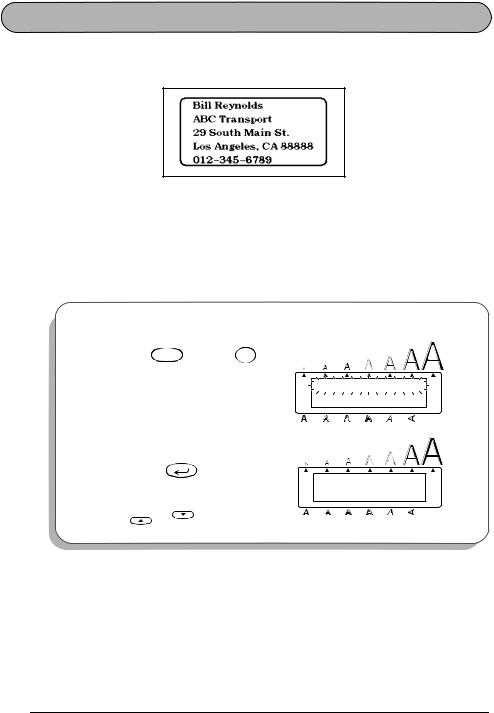
ADDRESS LABEL EXAMPLE
While making the multi-line address label in this example, we will learn how to create more decorative labels using the various format settings.
Five-line labels, such as this address label, can only be printed on either 3/4” (18-mm)- or 1” (24-mm)-wide tape.
Before entering the new text, we must first erase the text shown in the display from the previous time that the machine was used. When clearing the display, we can choose whether to erase all of the text and return all format functions (Font, Size, Width, Style, Underline, Frame,
Tape margin, Horizontal alignment, Tab Length, Mirror printing and Length) to their default settings or just to erase the text.
To erase all of the text and reset the format functions:
Clear
1 Hold down Code and press Del once.
2 Since TEXT&FORMATS is already selected, press New Block .
If TEXT&FORMATS was not already selected, it could be selected by press-
ing Home or |
. |
|
End |
Alt
Caps
Alt
Caps
T E X T & F O R M A T S |
Length |
|
Undl/Frm |
||
T E X T O N L Y |
||
A.Format |
||
|
Width |
|
Length |
1: _ |
Undl/Frm |
A.Format |
|
|
Width |
18
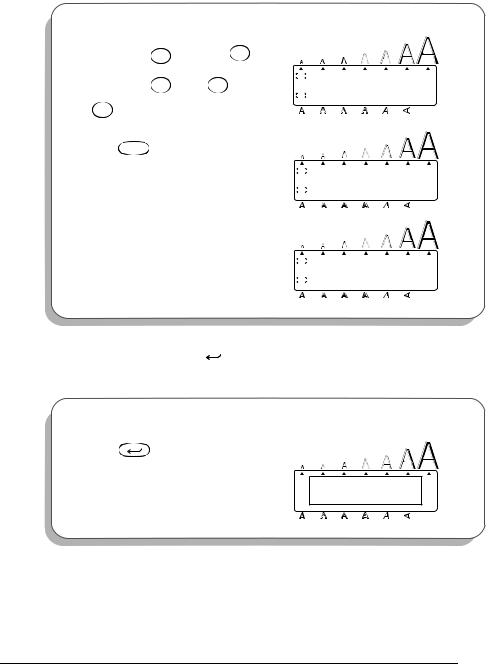
ENTERING THE TEXT
Let’s begin by typing in the first row of text, the name “Bill Reynolds”.
To type in “Bill Reynolds”:
|
|
Caps |
|
B |
|
|
|
|
|
|
|
|
3 Hold down |
Shift |
and press |
once, |
|
|
|
|
|
||||
|
|
|
|
|
|
|||||||
|
|
Caps |
Barcode |
|
|
|
|
|
|
|
|
|
|
|
|
|
|
Alt |
|
O K |
T O |
|
Length |
||
then release |
Shift |
. Press I í |
once, then |
|
|
|
|
Undl/Frm |
||||
|
|
|
1: B i l l _ |
|
||||||||
|
|
|
|
|
|
|
Caps |
|
|
A.Format |
||
L ú |
|
|
|
|
|
|
|
|
|
|
|
|
twice. |
|
|
|
|
|
|
|
|
Width |
|
||
4 Press |
Feed&Cut |
|
|
|
|
|
|
|
|
|
|
|
Space . |
|
|
|
|
|
|
|
|
|
|
||
|
|
|
|
|
|
|
|
|
|
|
|
|
|
|
|
|
|
|
|
Alt |
|
O K |
T O |
|
Length |
|
|
|
|
|
|
|
|
|
1: B i l l _ |
|
Undl/Frm |
|
|
|
|
|
|
|
|
Caps |
|
|
A.Format |
||
|
|
|
|
|
|
|
|
|
|
|
|
|
|
|
|
|
|
|
|
|
|
|
Width |
|
|
5 Type in “Reynolds”. |
|
|
|
|
|
|
|
|
|
|||
Again, the text is longer than the LCD |
|
|
|
|
|
|||||||
display. So “Bil” moves off the display |
|
|
|
|
|
|
||||||
Alt |
|
O K |
T O |
|
Length |
|||||||
to the left. |
|
|
|
|
|
|
|
|
||||
|
|
|
|
|
|
|
|
Undl/Frm |
||||
|
|
|
|
|
|
|
1: l |
R e y n o l d s _ |
|
|||
|
|
|
|
|
|
|
Caps |
|
|
A.Format |
||
|
|
|
|
|
|
|
|
|
|
|
|
|
|
|
|
|
|
|
|
|
|
|
|
|
|
|
|
|
|
|
|
|
|
|
|
Width |
|
|
In a multi-line label, the return key (  ) is used to end one line and start the next one. The return mark (
) is used to end one line and start the next one. The return mark ( 
 ) indicates the end of the line.
) indicates the end of the line.
To end the first line and begin another one:
|
New Block |
6 Press |
. |
Alt |
1: B i l l R e y n o l |
Length |
|
2: _ |
Undl/Frm |
Caps |
A.Format |
|
|
|
Width |
19
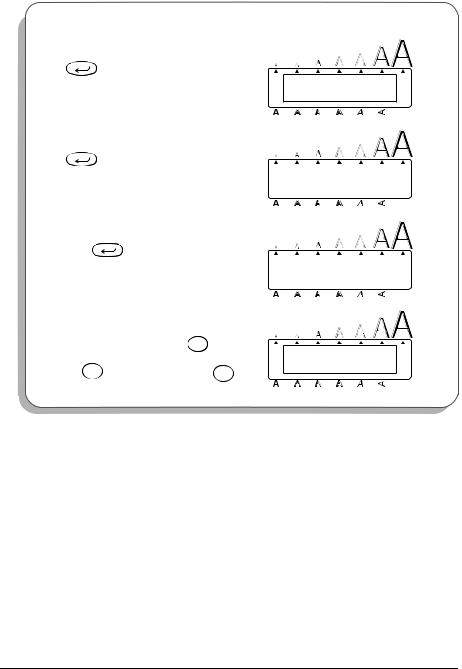
Now, we can enter the company name, address, and telephone number: ABC Transport; 29 South Main St.; Los Angeles, CA 88888; 012-345-6789.
To type in the company name, address, and telephone number:
7 Type “ABC Transport”, and then press
New Block .
Alt 2: A B C T r a n s p o |
|
Caps |
3: _ |
Length
Undl/Frm
A.Format
Width
8 Type “29 South Main St.”, and then press
New Block .
Alt
Caps
3: 2 9 |
S o u t h M a |
Length |
|
Undl/Frm |
|||
4: _ |
|
||
|
A.Format |
Width
9 Type “Los Angeles, CA 88888”, and then press .
Alt
Caps
4: L o s A n g e l e s |
Length |
|
Undl/Frm |
||
5: _ |
||
A.Format |
Width
0 Type “012-345-6789”.
|
Symbol |
|
|
To type “-”, hold down Alt |
and press |
||
/ |
|
Symbol |
|
once, and then release |
Alt . |
||
, - |
|||
Alt
Caps
4: s A n g e l e s , |
Length |
Undl/Frm |
|
5: 2 - 3 4 5 - 6 7 8 9 |
_ A.Format |
|
Width |
20
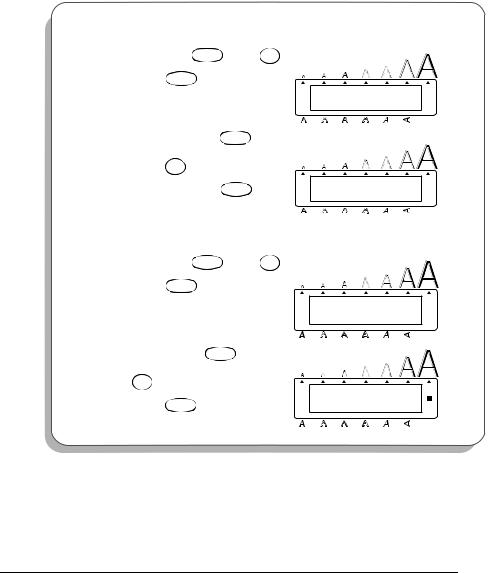
FORMATTING THE TEXT
Now the text is entered as we wish. If it were printed, the standard default settings would be used. The text would be aligned on the left side with 1 1/24” (25 mm) margins and would not be framed or underlined. In addition, the characters would be auto-sized (AUTO) and printed using the HELSINKI font and NORMAL style settings. For more details concerning format settings, please see pages 68 through 82.
For this label, though, let’s assume we want a different style of text: BRUSSELS font, framed, and printed with 1/6” (4 mm) margins (NONE). Therefore, we must change the format.
To select the BRUSSELS font setting:
A While holding down |
Code |
, press |
Font |
|
1 ¡ |
||||
|
|
|
|
! |
once, and keep |
Code |
held down to dis- |
||
play the current font setting. |
|
|
||
B While still holding down |
Code , |
con- |
||
tinue pressing |
Font |
until |
BRUSSELS is |
|
1 ¡ |
||||
|
! |
|
|
|
displayed, and then release |
Code . |
|
||
Alt
Caps
Alt
Caps
F O N T
H E L S I N K I
F O N T
B R U S S E L S
To select the ROUND frame setting:
C While holding down |
Frame |
Code , press 6 |
|
|
¢ |
once, and keep Code |
held down to dis- |
play the current frame setting.
Alt
Caps
F R A M E O F F
D While still holding down |
Code , continue |
|
Frame |
until ROUND is displayed, |
|
pressing 6 |
||
¢ |
|
|
|
|
Alt F R A M E |
and then release Code . |
Caps R O U N D |
|
Length
Undl/Frm
A.Format
Width
Length
Undl/Frm
A.Format
Width
Length
Undl/Frm
A.Format
Width
Length
Undl/Frm
A.Format
Width
21
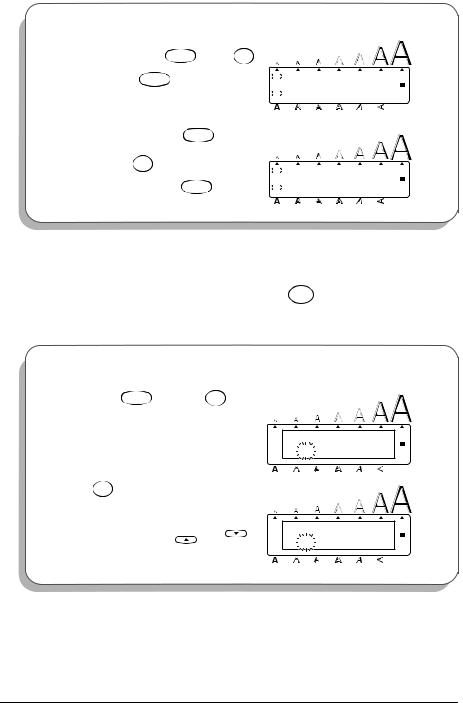
To select the NONE tape margin setting:
|
|
|
Tape |
|
|
|
|
|
E While holding down |
Code |
, press E |
|
|
|
|
||
|
|
|
|
|
|
|
|
|
once, and keep |
Code |
held down to dis- |
Alt |
|
F E E D |
Length |
||
|
|
|
|
|
|
|
F U L L |
Undl/Frm |
play the current tape margin setting. |
Caps |
|
A.Format |
|||||
|
|
|
|
|
|
|
|
Width |
F While still holding down |
Code , con- |
|
|
|
|
|||
|
Tape |
|
|
|
|
|
|
|
tinue pressing |
E until NONE is dis- |
|
|
|
|
|||
|
|
|
|
|
Alt |
|
F E E D |
Length |
played, and then release |
Code . |
|
|
|
N O N E |
Undl/Frm |
||
|
Caps |
|
A.Format |
|||||
|
|
|
|
|
|
|
|
Width |
Different format settings can be chosen either before or after the text is entered. The procedure shown above can also be used to change the other format settings.
PRINTING THE TEXT |
Mirror |
|
If we want only one copy of the text, we could just press |
to print it. However, let’s |
|
assume that we have three letters onto which we wish to attach address labels. Therefore, we |
||
need to print three copies of the same text. |
|
|
To print three copies of the label:
|
|
Repeat |
|
|
|
|
G Hold down |
Code and press |
O ó |
once. |
|
|
|
|
|
|
|
Alt |
C O P I E S |
Length |
|
|
|
|
|
1 |
Undl/Frm |
|
|
|
|
Caps |
A.Format |
|
|
|
|
|
|
|
Width |
Width |
once. |
|
|
|
|
|
H Press 3 |
|
|
|
|
|
|
# |
|
|
|
|
|
|
The number can be entered either by |
|
|
|
|||
typing it in using the number keys or |
Alt C O P I E S |
Length |
||||
by selecting it using Home |
and |
. |
|
3 |
Undl/Frm |
|
|
|
|
End |
Caps |
A.Format |
|
|
|
|
|
|||
|
|
|
|
|
|
Width |
22
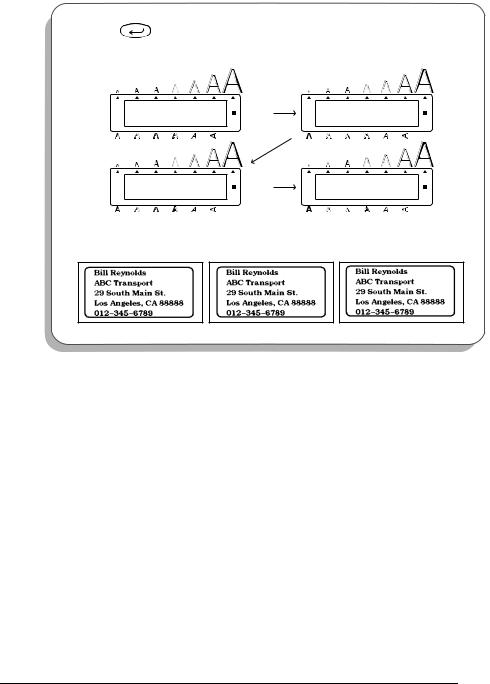
|
New Block |
I Press |
to begin printing. The message “WORKING” appears just before |
printing, and then the number of each copy being printed is displayed.
Alt
Caps
Alt
Caps
W O R K I N G
C O P I E S 2 / 3
Length |
Alt |
C O P I E S |
Length |
|
Undl/Frm |
|
1 / |
3 |
Undl/Frm |
A.Format |
Caps |
A.Format |
||
Width |
|
|
|
Width |
Length |
Alt |
C O P I E S |
Length |
|
Undl/Frm |
|
3 / |
3 |
Undl/Frm |
A.Format |
Caps |
A.Format |
||
Width |
Width |
If the A.Cut function is set to ON, each label is automatically cut off after it is printed.
23

STORAGE SHELF LABEL EXAMPLE
In this final example, we will practice using the New block function and the Local format function as well as more specialized features such as the Barcode and Numbering functions. The following labels, which could be used to describe objects stored on a shelf, contain multiple blocks and mixed formatting.
The labels in this example were made using 3/4” (18-mm)-wide tape.
Before entering our new text, we must first erase the text from the previous time that the P-touch was used.
To clear the working area for a new label:
Clear
1 Hold down Code and press Del once.
Alt
Caps
T E X T & F O R M A T S T E X T O N L Y
Width
Length
Undl/Frm
A.Format
2 Since |
TEXT&FORMATS |
is |
already |
|
|
||
selected, press |
New Block . |
|
|
|
|
||
|
|
|
|
|
Alt |
|
|
If TEXT&FORMATS was |
not |
already |
Caps |
1: _ |
|||
selected, it could be selected by press- |
|||||||
|
|
||||||
ing |
Home or |
. |
|
|
|
|
|
|
|
End |
|
|
|
|
|
Length
Undl/Frm
A.Format
Width
24
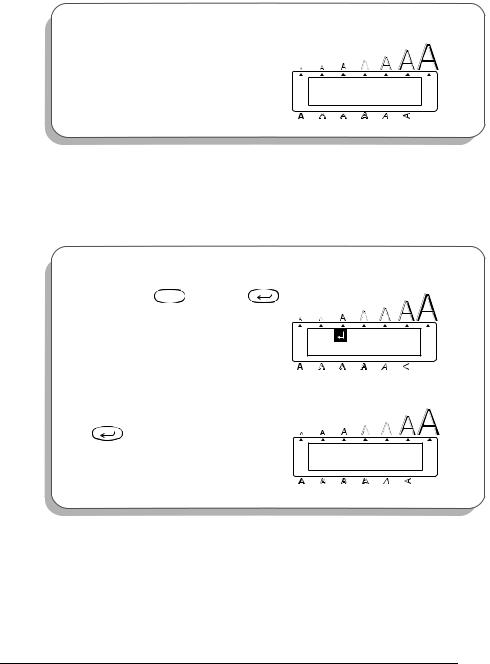
ENTERING THE TEXT
Now, we can begin entering the text for our storage shelf label.
To input the shelf number (the first block of text):
3 Type in “B1”.
Alt |
|
Length |
|
1: B 1 _ |
Undl/Frm |
Caps |
A.Format |
|
|
|
Width |
Each time the number of lines in a section of the text changes, a new block of text must be created. Therefore, the text for our label must be entered in three separate blocks.
Since we will now change from a one-line to a three-line block, we will use the New block function instead of a normal return. The new block mark (  ) indicates the end of a block. For more details on the New block function, refer to NEW BLOCK FUNCTION on page 40.
) indicates the end of a block. For more details on the New block function, refer to NEW BLOCK FUNCTION on page 40.
To create a new block of text:
New Block
4 Hold down Code and press
once.
Alt |
1: B 1 |
Length |
|
1: _ |
Undl/Frm |
Caps |
A.Format |
|
|
|
Width |
To enter the company address (the second block of text):
5 Type “ABC Transport”, and then press
New Block
.
Alt |
1: A B C T r a n s p o |
Length |
|
2: _ |
Undl/Frm |
Caps |
A.Format |
|
|
|
Width |
25
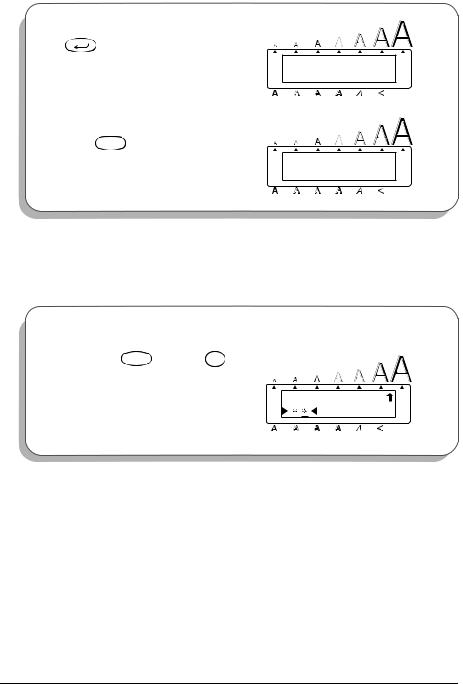
6 Type “29 South Main St.”, then press
New Block
.
Alt |
2: 2 9 |
S o u t h M a |
Length |
|
3: _ |
|
Undl/Frm |
Caps |
|
A.Format |
|
|
|
|
Width |
7 Type “Los Angeles, CA 88888”, hold
down Code and press  once.
once.
Alt |
3: L o s A n g e l e s |
Length |
|
1: _ |
Undl/Frm |
Caps |
A.Format |
|
|
|
Width |
Now, we must enter the third block of the text: the barcode. Although there are many barcode types available, let’s use CODE 39, which can use an unrestricted number of digits. More details on the Barcode function can be found on pages 83 through 86.
To add the barcode for the part code (the third block):
Barcode
8 Hold down Code and press I í once.
Alt |
C O D E |
3 9 |
Length |
|
|
|
Undl/Frm |
Caps |
|
|
A.Format |
Width
26
